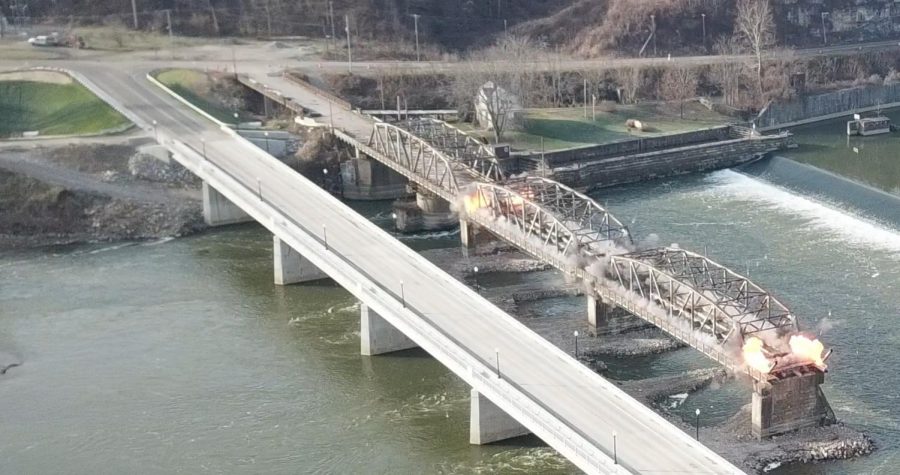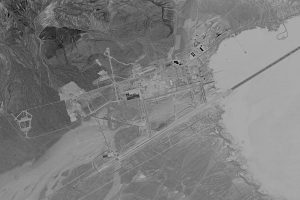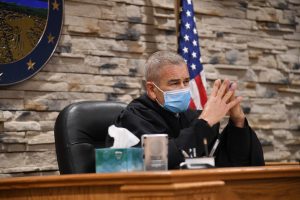Old Philo bridge being demolished
December 17, 2020
An iconic piece of local history for the communities of Philo and Duncan Falls met its fate Tuesday morning when explosives were taken to the structure of the old 1954 bridge connecting the two river-side towns.
While the bridge wasn’t the first to connect the two communities, it was a sight many local residents grew accustomed to seeing in their daily lives over its six-decades of service.
The bridge was recently closed to pedestrian and vehicular traffic back in October when the new, $12 million dollar, Lieutenant Michael J. Lutz Memorial bridge was christened.
Photos and videos shared online show the opening of the bridge in 1954 to large crowds and a parade by eager community members.
Those memories, many posted on social media by community elders who were children at the time of its construction, wrote about attending the ceremony and posted copies of family photos taken at the event.
The entire celebration shows a stark contrast to the one held in October when the pandemic and social distancing requirements kept most community members from attending.
Those health orders however did not keep residents from walking to the bridge in the following hours and days, many of whom later posted selfies and pictures of family members with the newly opened bridge when it was easier to social distance.
Muskingum County Sheriff Matt Lutz, whose father the bridge is named after, said he was very thankful to the county commissioners and the public for such a tribute.
“My dad was not somebody who would be looking for recognition or for awards, but he would surely be humbled and honored to have this bridge named after him,” said Lutz during the dedication.
When the now decommissioned Philo Bridge was built in the 1950s, its predecessor was completely raised before construction began, severely limiting travel between the two communities the bridge was there to connect.
To alleviate local’s concerns, a temporary pedestrian walking bridge was constructed across the water until the bridge could be opened to the public.
Vehicular traffic was forced to either travel further north or further south to other river-crossing bridges if they wished to travel east or west across the river.
When christened, the bridge became another structure in the multi-century-long history of bridges connecting the two communities, from early beginnings utilizing a wooden covered structure to steel beams, each iteration would increase the maximum weight and size of traffic that could cross.
Ultimately though however, even a restoration done to the bridge in the 1970s couldn’t save the sixty-year-old structure.

As Muskingum County Engineer Mark Eicher explained, over time the return on investment of maintenance begins to run financially against the cost of demolition.
It was that determination, made by the previous administration, that embarked the county on being the recipient of a new bridge.
Without federal pass-through dollars allocated to the State of Ohio, it’s likely the bridge would have never been build, due to extensive costs that would hinder other maintenance and construction projects throughout the county.
The need for the new bridge greatened when a fracture critical inspection completed in 2019 revealed concerns to engineers who ultimately made the decision to limit traffic to one lane, with traffic lights directing vehicles and pedestrians when to cross.
Higher than expected river flows also pushed back the planned opening of the bridge during its multi-year construction, but crews took every opportunity, often working in multiple shifts when weather was favorable to make up for lost time.
Eicher says the new bridge will easily go 40 to 50 years without needing repairs, though it will need to be inspected yearly as required by law.
Demolition, which first started earlier in the month, will likely not be completely finished until spring, as impending winter weather will limit further work.
The third phase, removal of the swing span portion of the bridge, will occur at a later date and utilize a crane due to its proximity to land, marking the end of any explosives being used for the project.
Next, the sandstone piers will need to be manually removed out of the river with some stones being saved for a park that is being established on the Philo side of the river.
While details are still sparse on what all the park will entail, Eicher said it will help beautify the area and lay tribute to the community and its residents.
“It’s a great project,” Eicher said about the newly constructed bridge and future park. “We’re just very proud to be able to have named this in honor of Lieutenant Lutz.”
Also soon to be added are flag poles at each end of the bridge, funded by the Muskingum County Commissioners.
Commissioner Jim Porter said he was approached by a member of the honor guard during a recent wreath-laying ceremony for Veterans Day at the county courthouse.
“They brought to our attention there was no flag at the bridge and wanted to know what we could do about it,” said Porter.
A staunch supporter of veterans, Porter took the request to the other two county commissioners, Cindy Cameron and Mollie Crooks, both of whom supported the funding idea.
As the bridge project nears completion, both communities will have an American flag flying near the entrances, visible to all who drive past.
“When the veterans ask you to do something you do it,” said Porter. “Now anytime someone goes by that bridge for likely the next century, they will be reminded of the service of our local veterans.”
















